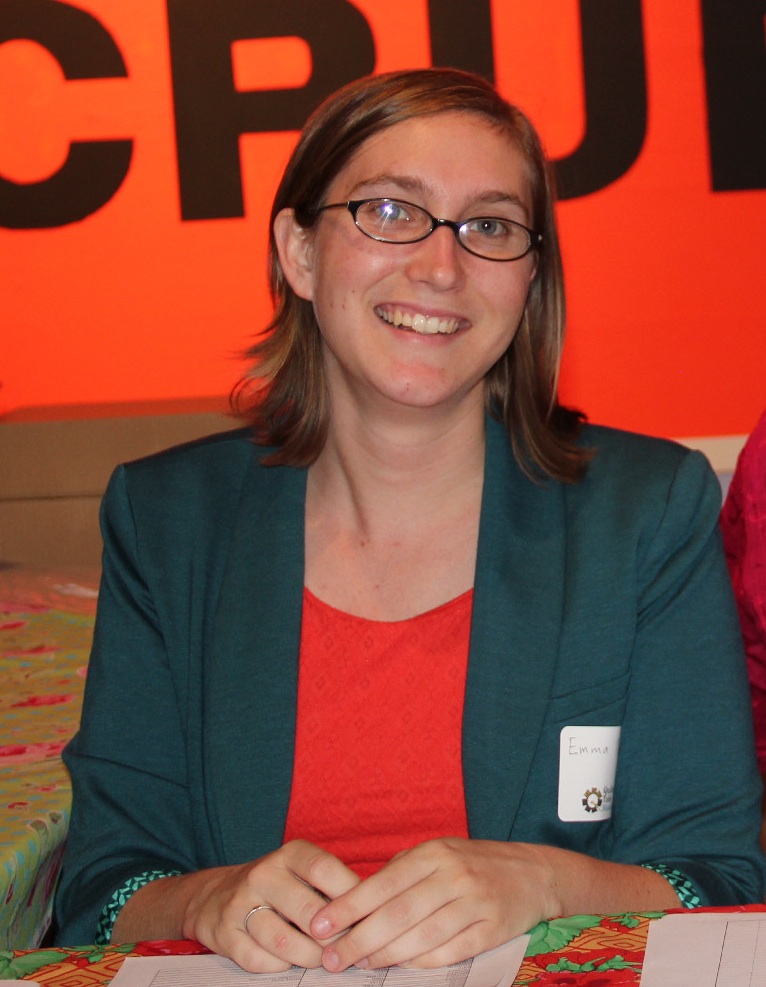 “Periwinkle Dreams” is a quilt that I made with a group of other quilt artists gathered together by Judy House. The quilts were destined to be hanging at Walter Reed in the cancer treatment area, and Judy had been ill with cancer and was treated at Walter Reed. Some of us were students of hers and some were nationally known quilters. We all chose a theme of plants or underwater sea creatures or some other form of natural substance that was being used for chemotherapy research and periwinkle apparently has been used. I know someone else made a large quilt with the periwinkle flower, but I was particularly drawn to making the flowers smaller, they are in the forefront of my quilt, and then there is this lovely garden hillside behind it and a blue sky and a tree and a fence and there is a little feeling of the pathway, two pathways running through the garden part. We met several times at Judy’s friend, Kay Lettau’s, house, and we would go there with different drawings of what we were going to be working on and kind of went around the circle and everyone talked about what they were going to do. Mine had warped from something else that was bigger into this particular style that just felt really right.”
“Periwinkle Dreams” is a quilt that I made with a group of other quilt artists gathered together by Judy House. The quilts were destined to be hanging at Walter Reed in the cancer treatment area, and Judy had been ill with cancer and was treated at Walter Reed. Some of us were students of hers and some were nationally known quilters. We all chose a theme of plants or underwater sea creatures or some other form of natural substance that was being used for chemotherapy research and periwinkle apparently has been used. I know someone else made a large quilt with the periwinkle flower, but I was particularly drawn to making the flowers smaller, they are in the forefront of my quilt, and then there is this lovely garden hillside behind it and a blue sky and a tree and a fence and there is a little feeling of the pathway, two pathways running through the garden part. We met several times at Judy’s friend, Kay Lettau’s, house, and we would go there with different drawings of what we were going to be working on and kind of went around the circle and everyone talked about what they were going to do. Mine had warped from something else that was bigger into this particular style that just felt really right.” town at the base of the castle. We went further north toward Porto and outside of Porto there is an incredible Iron Age village called Citania de Briteros that kind of makes the hair on the back of your neck stand up. It is just these huts with little kind of walkways with gutters in them and at the time there was a man who lived there who was the caretaker but it didn’t have a lot of protection the way you would think something would that is kind of a national treasure. They also had Roman ruins in Portugal, and we really enjoyed seeing mosaics and other evidences of the Roman presence, and Coimbra had this beautiful library. I think I’ve always been fascinated with architectural details.
town at the base of the castle. We went further north toward Porto and outside of Porto there is an incredible Iron Age village called Citania de Briteros that kind of makes the hair on the back of your neck stand up. It is just these huts with little kind of walkways with gutters in them and at the time there was a man who lived there who was the caretaker but it didn’t have a lot of protection the way you would think something would that is kind of a national treasure. They also had Roman ruins in Portugal, and we really enjoyed seeing mosaics and other evidences of the Roman presence, and Coimbra had this beautiful library. I think I’ve always been fascinated with architectural details.
I’ll spring forward to London because that is one place where we really visited several stately homes. I was able to take a survey course of different periods, like the Georgian Period. We would learn about some of the art, the architecture, the gardens, the silver, everything from that period with just a little short history of who was the king, and what was going on in terms of political intrigue or whatever. We would visit the Victoria and Albert Museum and I think this class lasted probably three or four months. It was down in Kensington and that was a real highlight for me. I have always loved the skylines; the rooflines in England are just fascinating and if you go to a castle and you are able to look at some of the chimney pots that are intricately decorated, these brick chimney pots that swirl around or they have a step like effect in them. Then you think of seeing a roofline and chimneys in Holland and you realize that there are some similarities that cross over and you are reminded of all the explorers. The Portuguese certainly got around everywhere, and the quality of learning the history and having lived in Europe was fascinating. When we were posted in Brazil I was involved with the American Women’s Club and we helped to start a nursery school in an orphanage. There was amazing poverty in Brasilia. The capitol itself is middle class and then there are some very, very wealthy people there. In the outlying satellite cities it can be extremely poor. We were invited to visit our, well we went to one wedding of a very working class family and were invited to another one and really got to see how the other half lived and visiting the orphanage was an eye opener. Through the American Women’s Club, we raised money for wheelchairs for people who lived in just poverty stricken areas. I came back with just a huge awareness of how fortunate Americans are and how much we have. ”
You can read more quilt stories on the Quilters’ S.O.S.- Save Our Stories page on the Quilt Alliance website.

Posted by Emma Parker
Project Manager, Quilters’ S.O.S.- Save Our Stories
qsos@quiltalliance.org

An interesting read but I am taking umbrage at your statement of “amazing poverty in Brazil” and your visit to a’ VERY working class wedding” being eye openers. Have you never seen poverty in the USA? ( I am presuming you are US citizens) Poverty is NEVER amazing, it is always only demeaning for poor people to be exposed to statements such as I have just read….. Count yourself lucky not to be poor. Most of the world is just that….
Hi Ankie,
Thanks so much for your thoughtful comment. This is an excerpt from an interview conducted several years ago with quilter Annabel Ebersole. Annabel clarified that she did not mean ‘amazing’ with any positive connotation, only that it was poverty of a magnitude she’d not seen before, abroad or in the US.
-Emma Parker
Q.S.O.S. Project Manager